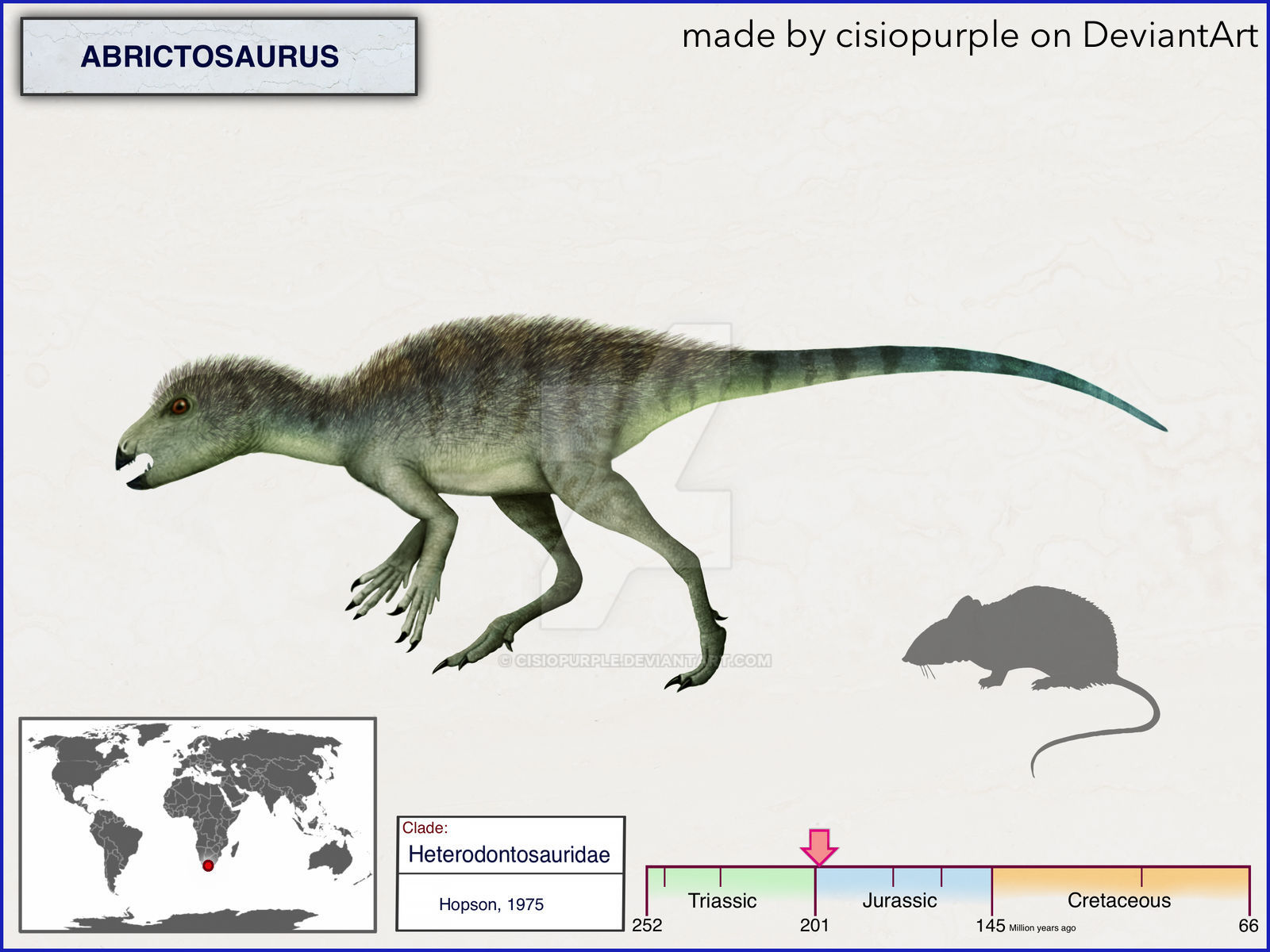Welcome to Abrictosaurus

Name Definition
Wakeful lizard
Name Given By
Hopson, 1975
Location
Cape Province and Upper Elliot Formation of South Africa
Classification
Dinosauria, Ornithischia, Heterdontosauridae, Heterodontosaurinae
Size
Roughly 0.39 meters tall (1.3 ft), 1.2 meters long (3.9 ft), approximately 45 kg (100 lbs)
Temporal Range
Hettangian - Sinemurian ages of the Early Jurassic, 199 - 196 million years ago
Ecological niche
Small agile herbivore/omnivore
Species/Sub Species
A. consors
Diet
Abrictosaurus would have first stripped off vegetation from low growing plants and then chewed it inside its mouth, though due to its heterodont dentition, it may have hunted small insects and vertebrates as well
Introduction
Abrictosaurus is a genus of heterodontosaurid dinosaurs that lived in South Africa during the early Jurassic. When first described in 1974, Abrictosaurus was originally named as a species of a different heterodontosaurid genus called Lycorhinus. Richard Thulborn named this new species Lycorhinus consors and the description was based on the partial skull and skeleton UCL B54, which seemed to be from the type species Lycorhinus agustidens, but was lacking the tusk like teeth present in L. agustidens. Then, in 1975, another skull (UCL A100) was found and attributed to L. agustidens. However, James Hopson examined this new skull and found it had differentiating features distinguishing it from L. agustidens but was more similar to UCL B54, and then attributed these two skulls to a new genus of heterdontosaurid which he named Abrictosaurus. Abrictosaurus is still only represented by 2 individuals, one with tusks and the other without.
Tusks are a common factor in sexual dimorphism and are present in many extant animals like walrus, musk deer, and elephants where the males usually have the tusks for visual display and combat but the females do not. The lack of tusks in UCL B54 have led scientists to believe it was a female, although it could have possibly been a female of a different species. Tusks are present on the specimen UCL A100, which would make this one a male, and suggests that it is still its own valid species. However, UCL B54 may be a juvenile since its sacral (hip) vertebrae are unfused and it has a shorter face. If it isn’t mature, then the lack of tusks may be due to sexual immaturity. If the tusks were really a trait of sexual dimorphism, then these tusks would have only been a display feature. Another theory is that UCL B54 was a new genus entirely and was more basal than other heterodontosaur genera, which could explain why the tusks wouldn't have evolved yet. Another popular theory is that its tusks were used for feeding purposes. These tusks could be useful for digging up roots. The beak was also good for cropping vegetation. However, it has also been proposed that heterodontosaurids were omnivorous, and these body features could have been used to catch smaller animals or consume meat. This is also supported by the fact that heterodontosaurids were some of the most basal ornithischians, and animals basal in a lineage are usually generalists, meaning that they are more adaptable than specialized animals of a lineage and are usually able to consume a wider variety of food. Heterodontosaurids were also named after their heterodont dentition, and the so called tusks also resemble the canines of carnivoran mammals. While there is no direct evidence, omnivory is a plausible theory and may still be present in heterodontosaurs.
Sources:
- https://en.wikipedia.org/wiki/Abrictosaurus
- http://www.prehistoric-wildlife.com/species/a/abrictosaurus.html